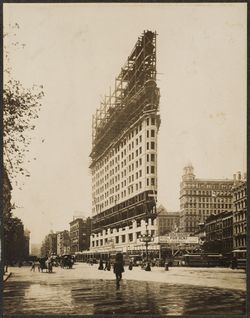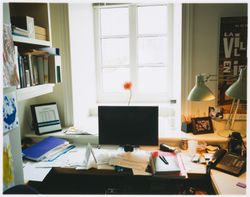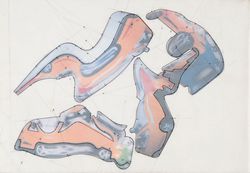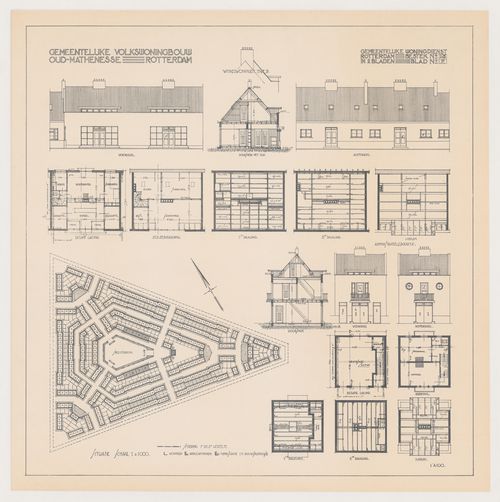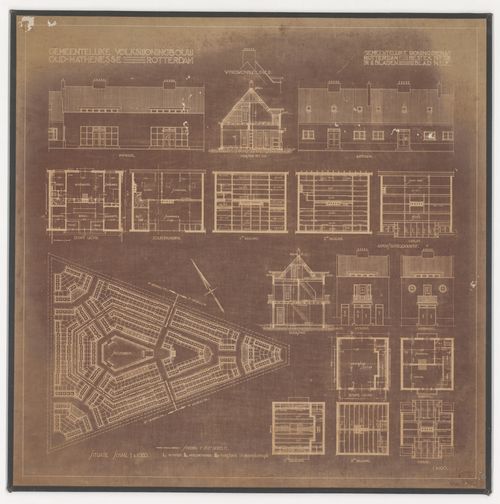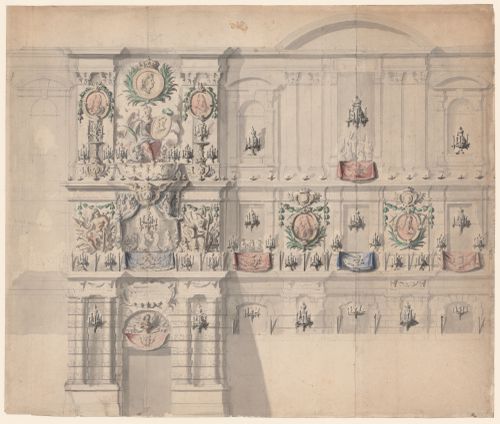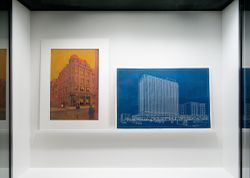L’exposition Architectes de l’image : les photographes à l’âge héroïque des grands travaux fait ressortir les liens entre la représentation photographique et les grands travaux entrepris au cours du premier siècle de développement de la photographie dans les domaines de l’architecture et de l’ingénierie. L’idée centrale de l’exposition – le photographe vu comme un(...)
11 octobre 1995 au 4 février 1996
Architectes de l'image : les photographes à l'âge héroïque des grands travaux
Actions:
Description:
L’exposition Architectes de l’image : les photographes à l’âge héroïque des grands travaux fait ressortir les liens entre la représentation photographique et les grands travaux entrepris au cours du premier siècle de développement de la photographie dans les domaines de l’architecture et de l’ingénierie. L’idée centrale de l’exposition – le photographe vu comme un(...)
Le bâtiment du Centre Canadien d’Architecture (CCA) fut conçu à la fois comme une extension de la maison Shaughnessy, une résidence construite au XIXe siècle, et comme un objet à part entière de la collection. Le CCA est inauguré en 1989 avec l’exposition Architecture et paysage qui présentait le nouvel édifice et ses jardins. En tant qu’acteur essentiel dans la recherche(...)
Vitrines
22 avril 2015 au 30 novembre 2015
Photographies du CCA, 1987-2015
Actions:
Description:
Le bâtiment du Centre Canadien d’Architecture (CCA) fut conçu à la fois comme une extension de la maison Shaughnessy, une résidence construite au XIXe siècle, et comme un objet à part entière de la collection. Le CCA est inauguré en 1989 avec l’exposition Architecture et paysage qui présentait le nouvel édifice et ses jardins. En tant qu’acteur essentiel dans la recherche(...)
Vitrines
articles
Trajets et transferts
Dans cette conférence, Amy Kulper situe le « virage numérique » de l’architecture en 1988, avec la création de Photoshop par Thomas Knoll. Développé à l’origine en tant que logiciel d’édition d’images, Photoshop s’inscrivait parfaitement dans la longue histoire de la correction optique dans la discipline architecturale. Pourtant, son omniprésence aujourd’hui soulève de(...)
Théâtre Paul-Desmarais
9 juin 2016, 18h
Amy Kulper : Le « virage numérique » et l’avènement de Photoshop
Actions:
Description:
Dans cette conférence, Amy Kulper situe le « virage numérique » de l’architecture en 1988, avec la création de Photoshop par Thomas Knoll. Développé à l’origine en tant que logiciel d’édition d’images, Photoshop s’inscrivait parfaitement dans la longue histoire de la correction optique dans la discipline architecturale. Pourtant, son omniprésence aujourd’hui soulève de(...)
Théâtre Paul-Desmarais
DR1984:0509
Description:
- A legend at the bottom of the drawing indicates that solid lines represent houses (WONINGEN), single hatching represents shop/houses (WINKELWONINGEN), and cross-hatching represents administration and fire station buildings (ADMINISTRATIE EN BRANDSPUITHUISJE).
architecture
printed 1922-1923
Site plan, floor, roof and framing plans, sections, and elevations for Oud-Mathenesse Housing Estate, Rotterdam, Netherlands
Actions:
DR1984:0509
Description:
- A legend at the bottom of the drawing indicates that solid lines represent houses (WONINGEN), single hatching represents shop/houses (WINKELWONINGEN), and cross-hatching represents administration and fire station buildings (ADMINISTRATIE EN BRANDSPUITHUISJE).
architecture
DR1984:0510
Description:
- A legend at the bottom of this drawing indicates that solid lines represent houses (WONINGEN), single hatching represents shop/houses (WINKELWONINGEN), and cross-hatching represents administration and fire station buildings (ADMINISTRATIE EN BRANDSPUITHUISJE).
architecture
printed 1922-1923
Site plan, floor, roof, and framing plans, sections and elevations for Oud-Mathenesse Housing Estate, Rotterdam, Netherlands
Actions:
DR1984:0510
Description:
- A legend at the bottom of this drawing indicates that solid lines represent houses (WONINGEN), single hatching represents shop/houses (WINKELWONINGEN), and cross-hatching represents administration and fire station buildings (ADMINISTRATIE EN BRANDSPUITHUISJE).
architecture
DR1967:0012
Description:
The drawing shows an elevation of the Porte Jean Goujon (now known as the Porte Barbet de Jouy) on the southern, quai-side façade of the Louvre, as well as part of the façade to the east of the portal. On the ground floor, candelabras line the windows and niches. The entry portal features a sculptural bust – likely a representation of Louis XIV – and a red banner with the king’s coat of arms. Above the portal’s tympanum is a large ovoid cartouche with faint script in black chalk that may read « Plate pour l’inscription, » indicating that the text had not yet been finalized at the time of the drawing’s creation. The heavily-decorated middle register features two over-life-size mythical and allegorical figures on either side of a balcony. To the left is Hercules, with his club, and to the right is an allegorical representation of Bellona. The balcony is hung with a blue tapestry woven with the king’s interlocking L monogram. Blue curtains with fleurs-de-lys hang over the balcony, revealing the revelers inside the building. These ornamental elements continue along the façade, which is hung with two large, circular portrait reliefs that likely show Louis XIV’s son, Grand Dauphin Louis, and grandson, Louis, the Duke of Burgundy, who was the father of the Duke of Brittany whose birth was being celebrated. Green watercolor paint is used to highlight the foliage festoons and palms that frame the portraits. On the top register of the portal is a seated allegorical figure holding a palm and a portrait, perhaps of the infant Louis, Duke of Brittany. Above her is a large, crowned medallion with the profile of Louis XIV in the guise of a Roman emperor surrounded by green palms. On either side of this central scene are large candelabras and circular portraits of the Grand Dauphin and the Duke of Burgundy. The architectural elements of the façade are carefully drawn in black chalk and faithfully render the architecture of the Louvre in the early eighteenth century.
architecture temporaire
circa 1704
Design for ceremonial decorations at the Louvre
Actions:
DR1967:0012
Description:
The drawing shows an elevation of the Porte Jean Goujon (now known as the Porte Barbet de Jouy) on the southern, quai-side façade of the Louvre, as well as part of the façade to the east of the portal. On the ground floor, candelabras line the windows and niches. The entry portal features a sculptural bust – likely a representation of Louis XIV – and a red banner with the king’s coat of arms. Above the portal’s tympanum is a large ovoid cartouche with faint script in black chalk that may read « Plate pour l’inscription, » indicating that the text had not yet been finalized at the time of the drawing’s creation. The heavily-decorated middle register features two over-life-size mythical and allegorical figures on either side of a balcony. To the left is Hercules, with his club, and to the right is an allegorical representation of Bellona. The balcony is hung with a blue tapestry woven with the king’s interlocking L monogram. Blue curtains with fleurs-de-lys hang over the balcony, revealing the revelers inside the building. These ornamental elements continue along the façade, which is hung with two large, circular portrait reliefs that likely show Louis XIV’s son, Grand Dauphin Louis, and grandson, Louis, the Duke of Burgundy, who was the father of the Duke of Brittany whose birth was being celebrated. Green watercolor paint is used to highlight the foliage festoons and palms that frame the portraits. On the top register of the portal is a seated allegorical figure holding a palm and a portrait, perhaps of the infant Louis, Duke of Brittany. Above her is a large, crowned medallion with the profile of Louis XIV in the guise of a Roman emperor surrounded by green palms. On either side of this central scene are large candelabras and circular portraits of the Grand Dauphin and the Duke of Burgundy. The architectural elements of the façade are carefully drawn in black chalk and faithfully render the architecture of the Louvre in the early eighteenth century.
architecture temporaire
Sur les traces des... gens
L’un des indicateurs de la modernité à partir du XVIIIe siècle est l’apparition des « gens » comme nouvelle entité politique respectée. En réponse à ce phénomène, les architectes se sont engagés dans la transformation des villes, ont exploré de nouvelles technologies, testé de nouveaux discours en architecture et ont pris part dans des conflits culturels enflammés – le(...)
Vitrines
5 octobre 2011 au 22 janvier 2012
Sur les traces des... gens
Actions:
Description:
L’un des indicateurs de la modernité à partir du XVIIIe siècle est l’apparition des « gens » comme nouvelle entité politique respectée. En réponse à ce phénomène, les architectes se sont engagés dans la transformation des villes, ont exploré de nouvelles technologies, testé de nouveaux discours en architecture et ont pris part dans des conflits culturels enflammés – le(...)
Vitrines
articles
Une histoire de rencontres
Forces de friction
Série(s)
AP012.S1
Description:
La série documente les projets architecturaux de Michaud depuis ses années d'études dans les années 1940 jusqu'à environ 1981. Environ 84 projets sont représentés principalement par des dessins et quelques documents textuels.
1946-1981, surtout 1950-1969
Projets d'étudiant et projets de l'architecte
Actions:
AP012.S1
Description:
La série documente les projets architecturaux de Michaud depuis ses années d'études dans les années 1940 jusqu'à environ 1981. Environ 84 projets sont représentés principalement par des dessins et quelques documents textuels.
Série 1
1946-1981, surtout 1950-1969
